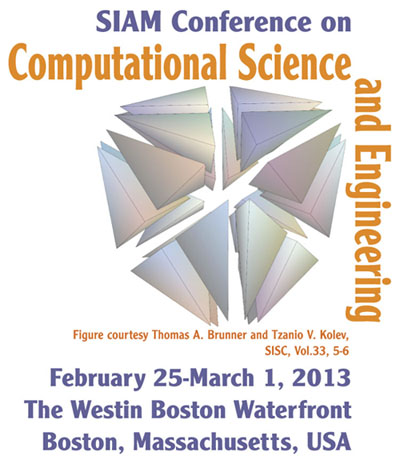
Sponsored by the SIAM Activity Group on Computational Science and Engineering.
To view photos from the Conference on Computational Science & Engineering, please visit http://on.fb.me/1a3Rcge.
Presentations from the Conference
Most of the invited speaker presentations and select minisymposia presentations from the 2013 Conference on Computational Science & Engineering have been captured and are available as slides with synchronized audio. In addition there are PDF’s of the slides available for printing. View presentation slides with synchronized audio.
Announcements
Best Student Poster Prize Winners Announced
1st Place
Optimal Dirichlet Boundary Control for the Navier-Stokes Equations abstract
Lorenz John and Olaf Steinbach, Graz University of Technology, Austria
2nd Place
Flexible Krylov Subspace Methods for Shifted Systems abstract
Tania Bakhos, Arvind Saibaba, and Peter K. Kitanidis, Stanford University, USA
The MIT Center for Computational Engineering proudly sponsored the Best Student Poster Prize at the SIAM Conference on Computational Science and Engineering (CSE13).
Local Activities and Points of Interest Flyer [PDF, 1.6MB]

We are pleased to announce that SISC will dedicate a special section in association with the CSE13 conference. The special section will focus on two themes – Planet Earth and Big Data – and will feature high-quality scientific-computing papers in either one or both (!) of these two areas.
 Math of Planet Earth 2013
Math of Planet Earth 2013
2013 is designated as the year of Math of Planet Earth. SIAM supports MPE2013.
To RSVP to the conference on Facebook and connect with other attendees, find roommates etc., please visit https://www.facebook.com/events/319439084830571/.
If you are tweeting about the conference, please use the designated hashtag to enable other attendees to keep up with the Twitter conversation and to allow better archiving of our conference discussions. The hashtag for this meeting is #SIAMCSE13.
Organizing Committee
Organizing Committee Co-chairs
Karen Willcox, Massachusetts Institute of Technology, USA
Hans Petter Langtangen, Simula Research Laboratory and University of Oslo, Norway
Organizing Committee
Omar Ghattas, University of Texas at Austin
Lutz Gross, University of Queensland, Australia
Michael A. Heroux, Sandia National Laboratories
Morten Hjorth-Jensen, Michigan State University, USA and University of Oslo, Norway
David Keyes, KAUST, Saudi Arabia
Randall J. LeVeque, University of Washington, USA
Kengo Nakajima, University of Tokyo, Japan
Luke Olson, University of Illinois at Urbana-Champaign, USA
Fernando Perez, University of California, Berkeley
Gianluigi Rozza, SISSA, International School for Advanced Studies, Trieste, Italy
Volker Schulz, University of Trier, Germany
Valeria Simoncini, Universita' di Bologna, Italy
Description
Computational Science and Engineering (CS&E) is now widely accepted, along with theory and experiment, as the critical third pillar of scientific discovery. It is indispensable for leading edge investigation and engineering design in a vast number of industrial sectors, including for example, aerospace, automotive, biological chemical, and semiconductor technologies that all rely increasingly on advanced modeling and simulation. CS&E has also become essential at government agencies for informing policy and decisions relating to human health, resources, transportation, and defense. Finally, in many new areas such as medicine, the life sciences, management and marketing (e.g. data- and stream mining), and finance, techniques and algorithms from CS&E are of growing importance.
CS&E is by nature interdisciplinary. Its goals concern understanding and analyzing complex systems, predicting their behavior, and eventually optimizing processes and designs. CS&E thus grows out of physical applications, while depending on computer architecture, and having at its core powerful algorithms. At the frontiers of CS&E there remain many open problems and challenges, including for example, the validation and verification of computational models especially in the presence of uncertainties and the analysis and assimilation of very large data sets, including techniques for visualization and animation.
The SIAM CS&E conference seeks to enable in-depth technical discussions on a wide variety of major computational efforts on large problems in science and engineering, foster the interdisciplinary culture required to meet these large-scale challenges, and promote the training of the next generation of computational scientists.
Funding Agency
SIAM and the Conference Organizing Committee wish to extend their thanks and appreciation to the U.S. National Science Foundation and the U.S. Department of Energy for their support of this conference.


Themes
- Multiphysics and Multiscale Computations
- Identification, Design, and Control
- Surrogate and Reduced-order Modeling
- Verification, Validation, Uncertainty Quantification
- Discrete Simulations
- Scientific Data Mining
- Scalable Algorithms for Big Data
- Simulations on Emerging Architectures
- Exascale Challenges
- Scientific Software and High-Performance Computing
- Applications in Science, Engineering, and Industry
- Computational Mathematics of Planet Earth
- CSE Education
Important Deadlines
SUBMISSION DEADLINES
August 13, 2012: August 31, 2012 Minisymposium proposals
September 10, 2012: Abstracts for contributed and minisymposium speakers
TRAVEL FUND APPLICATION DEADLINE EXTENDED
August 27, 2012 September 11, 2012: SIAM Student Travel Award and Post-doc/Early Career Travel Award Applications
PRE-REGISTRATION DEADLINE
January 28, 2013: January 30, 2013 Disconnect time is 4:00 PM EST
HOTEL RESERVATION DEADLINE
February 4, 2013


